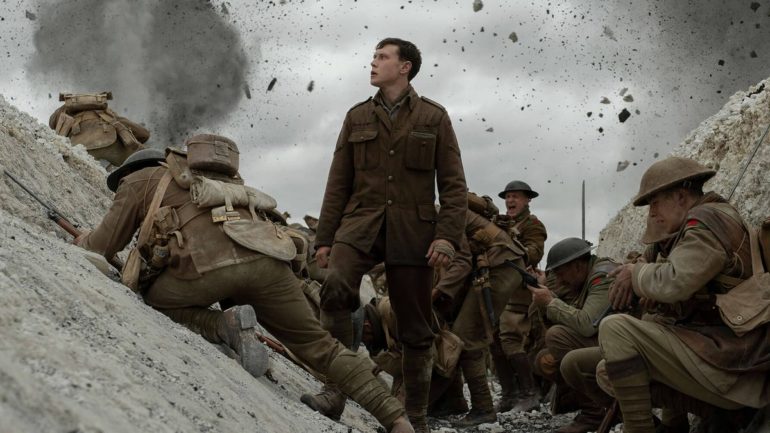Long takes, depending on who you ask, are either the holy grail of cinematic technique or distracting displays of showmanship. The first group say that an elaborate one shot is the ultimate test of a crew’s skill and a director’s vision, the second that directors use them mainly as a means of one-upping each other. If the latter is true then Sam Mendes has really thrown the gauntlet down with 1917.
This is a film comprised of nothing but long takes, with sneaky edits in between to make it appear as one continuous shot (e.g. when a character enters a dark room). It’s not the first time this sort of thing has been attempted. Some have actually done it for real (see Russian Ark) but the more famous examples, such as Birdman and Hitchcock’s Rope, have all been edit-hiding cheaters. So while Mendes may not be on virgin territory here, he compensates for it with spectacle and ambition.
Our single-shot-but-not-really begins with two soldiers, Blake and Scofield, receiving orders from their commanding officer. It turns out that the Germans are retreating from their front line. This is great news for Colonel MacKenzie who plans to have his troops chase after the fleeing “Huns” and turn the tide of the war.
Others think the whole thing sounds a little too good to be true, and it just so happens to be. Aerial photographs have shown that the Germans aren’t fleeing, they’re falling back to a new, heavily defended line. When MacKenzie attacks tomorrow morning, his troops will be obliterated, among them Blake’s brother.
Blake and Scofield are tasked with reaching MacKenzie and ordering him to call off the assault before it’s too late. Blake is the younger of the two, inexperienced and upbeat. Scofield is a bit more mysterious. He has seen a lot more action, most notably at the Somme. He earned a medal, though he doesn’t seem particularly proud of it.
Their journey will send them over the trenches, through the enemy front lines and into the green countryside of France. Along the way, they’ll meet German foes, Indian allies, French civilians, and many different commanding officers, all played by actors you’ll recognise. While they inject some gravitas into their brief scenes, throwing in famous faces among these unknown soldiers is a tad jarring. It’s not helped by the way the film likes to tease their faces out of shot. When they finally reveal themselves, you can almost hear the “Ta-Da!”.
Forget the cameos, the real star here is the craft. This is as much a filmmaking exercise as a film and it’s not the length of its takes that impresses, but their complexity and attention to detail. Showy or not, they create an almost video game-like sense of immersion, giving us the ability to move fluidly through trenches and across war-torn fields, to grab passing glimpses of trench life. We quickly meet a soldier waiting on the front line with a pipe and a dog on his lap. You could have made a whole movie about that.
Hundreds of troops crammed into trenches, bombed out cities illuminated by fire, the dramatic charge of No Man’s Land. These images, stunningly brought to life by legendary cinematography and Coen Brothers regular Roger Deakins, create a World War 1 that is bombastic and immediate. It’s not unlike what Peter Jackson achieved a few years ago with the documentary They Shall Not Grow Old, and reflect a similar wish to portray The Great War as an event that was truly lived, and not something that happened to a world of black and white.

